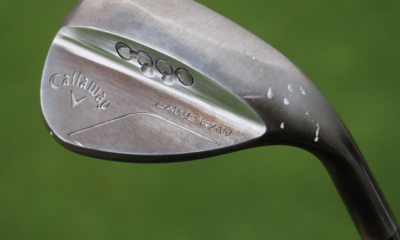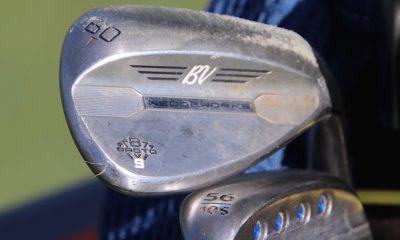Instruction
How to properly gap your wedges

Every golf equipment company has a theory and pitch for why you should play its wedges. I am here to say that, yes, certain wedges from certain manufacturers have advantages over others, both in performance and looks and feel. For that reason, golfers should spend some time determining what wedge is best for their game. If they don’t understand the process of wedge gapping, however, their next wedge purchase is unlikely to help them shoot lower scores.
The performance differences between today’s wedges include slight changes in spin production, sole grinds, stock shaft options, head construction and forgiveness. On the looks/feel side of things, there are big differences in head shape, finishes and feel. But again, these are secondary factors that should only be tackled once you properly gap your wedges. Doing so will not only give you more confidence about how far your wedges actually fly, but will leave you with fewer “tweener” yardages that are often harder to convert into birdies and pars.
So where should golfers start? Many fall into the trap of thinking that they need to buy specific wedges with specific lofts in order to achieve consistent yardage gaps. Sometimes they’re right, but before they make any new purchases they should first exhaust the simplest, most obvious solution. All they need to do is chart how far their wedges currently fly in the air, either on the course or on a launch monitor like Trackman. The feedback will be even more precise if you use the same golf ball you use when you play — and as I wrote about previously, premium golf balls are the way to go for a better wedge game.
To show you how important a wedge gapping is, I performed one on my wedge game with my Trackman. I currently use four wedges, and have a 4-degree loft separation between them as many players do. This is not done by customization, usually; it’s become the default configuration promoted by the manufacturers, and PW-52-56-60 or PW-50-54-58 are the most commonly recommended wedge sets.
As a PGA Professional, I’ve been so busy teaching in recent years that I haven’t gotten to play much golf, so I was particularly interested to see if I was playing a properly gapped set of wedges.
My current wedges
- TaylorMade PSi Tour (PW) — 46 Degrees
- TaylorMade Tour Preferred (ATV Grind) — 50 Degrees
- TaylorMade ATV — 54 Degrees
- TaylorMade Tour Preferred (ATV Grind) — 58 Degrees
My average carry distances
- 115 yards,TaylorMade PSi Tour (PW) — 46 Degrees
- 104.1 yards,TaylorMade Tour Preferred (ATV Grind) — 50 Degrees
- 96.5 yards,TaylorMade ATV — 54 Degrees
- 88.8 yards,TaylorMade Tour Preferred (ATV Grind) — 58 Degrees
My gaps
- PW to GW: 10.9 yards
- GW to SW: 7.6 yards
- SW to LW: 7.7 yards
While my wedge gaps proved to be somewhat even, they were too close together. Do I really need four clubs for a distance range that covers less than 30 yards? The answer for me is no, so I will need to reconsider my wedge makeup to achieve the 12-yard gaps that I prefer.
Many golfers, especially those who have been playing a long time, will have different preferences about what they want their yardage gaps to be on full swings — 10 yards, 15 yards, 20 yards, etc. Generally, the more full swings golfers make with their wedges, the tighter their yardage gaps should be. Other players will never “max out” a wedge, preferring to hit finesse shots and alter their trajectory. These types of golfers generally play wedges with wider yardage gaps, as their distances are more feel-based.
Whatever type of wedge game you have, gapping is still of the utmost importance, because if you don’t know how far your wedges fly then you have no chance to play your best.
My friend Scott Felix, a Golf Digest Top 100 club fitter and owner of Felix Clubworks in Memphis, Tenn., says that every 1 degree change in wedge loft will create approximately a 3-yard change in carry distance. It’s not an exact science — if it was, my wedges would have already had 12-yard gaps between them — but it’s a good starting point.
The achieve more consistent wedge gaps, I have two choices, as many of you will as well:
- Bend the wedges I already have to lofts that create the yardage gaps I want.
- Identify what wedge lofts aren’t working for me, and replace them with new models.
Altering the loft of a wedge, which involves bending it weaker or stronger, changes more than loft — it also changes the bounce angle on the wedge’s sole, as well as its amount of offset. Adding loft increases bounce and removes offset, while decreasing loft decreases bounce and adds offset.
Most PGA Tour players are generally ok with bending their wedges 1-to-2 degrees, but after that the look and performance of a wedge will start to become noticeably affected.
I’m sure that some of you reading this story wish your 52-degree wedge went a little farther, shorter, whatever, but don’t have access to a loft/lie machine.
If you’re in the market for new wedges, and want to dial in your distances without needing to bend the lofts, there is a viable option — Ben Hogan wedges. The company’s new TK-15 wedges are offered in every loft between 45 and 62 degrees, meaning that each wedge is designed to be played at a specific loft. That allows the sole grinds and bounce characteristics stay consistent from loft to loft.
Regardless of what wedges you buy, however, make sure you get to the course or to a Trackman to figure out how far your wedges fly. That will help you understand what lofts you need to fill the troublesome gaps in your wedge game.
Instruction
The Wedge Guy: Beating the yips into submission

There may be no more painful affliction in golf than the “yips” – those uncontrollable and maddening little nervous twitches that prevent you from making a decent stroke on short putts. If you’ve never had them, consider yourself very fortunate (or possibly just very young). But I can assure you that when your most treacherous and feared golf shot is not the 195 yard approach over water with a quartering headwind…not the extra tight fairway with water left and sand right…not the soft bunker shot to a downhill pin with water on the other side…No, when your most feared shot is the remaining 2- 4-foot putt after hitting a great approach, recovery or lag putt, it makes the game almost painful.
And I’ve been fighting the yips (again) for a while now. It’s a recurring nightmare that has haunted me most of my adult life. I even had the yips when I was in my 20s, but I’ve beat them into submission off and on most of my adult life. But just recently, that nasty virus came to life once again. My lag putting has been very good, but when I get over one of those “you should make this” length putts, the entire nervous system seems to go haywire. I make great practice strokes, and then the most pitiful short-stroke or jab at the ball you can imagine. Sheesh.
But I’m a traditionalist, and do not look toward the long putter, belly putter, cross-hand, claw or other variation as the solution. My approach is to beat those damn yips into submission some other way. Here’s what I’m doing that is working pretty well, and I offer it to all of you who might have a similar affliction on the greens.
When you are over a short putt, forget the practice strokes…you want your natural eye-hand coordination to be unhindered by mechanics. Address your putt and take a good look at the hole, and back to the putter to ensure good alignment. Lighten your right hand grip on the putter and make sure that only the fingertips are in contact with the grip, to prevent you from getting to tight.
Then, take a long, long look at the hole to fill your entire mind and senses with the target. When you bring your head/eyes back to the ball, try to make a smooth, immediate move right into your backstroke — not even a second pause — and then let your hands and putter track right back together right back to where you were looking — the HOLE! Seeing the putter make contact with the ball, preferably even the forward edge of the ball – the side near the hole.
For me, this is working, but I am asking all of you to chime in with your own “home remedies” for the most aggravating and senseless of all golf maladies. It never hurts to have more to fall back on!
Instruction
Looking for a good golf instructor? Use this checklist

Over the last couple of decades, golf has become much more science-based. We measure swing speed, smash factor, angle of attack, strokes gained, and many other metrics that can really help golfers improve. But I often wonder if the advancement of golf’s “hard” sciences comes at the expense of the “soft” sciences.
Take, for example, golf instruction. Good golf instruction requires understanding swing mechanics and ball flight. But let’s take that as a given for PGA instructors. The other factors that make an instructor effective can be evaluated by social science, rather than launch monitors.
If you are a recreational golfer looking for a golf instructor, here are my top three points to consider.
1. Cultural mindset
What is “cultural mindset? To social scientists, it means whether a culture of genius or a culture of learning exists. In a golf instruction context, that may mean whether the teacher communicates a message that golf ability is something innate (you either have it or you don’t), or whether golf ability is something that can be learned. You want the latter!
It may sound obvious to suggest that you find a golf instructor who thinks you can improve, but my research suggests that it isn’t a given. In a large sample study of golf instructors, I found that when it came to recreational golfers, there was a wide range of belief systems. Some instructors strongly believed recreational golfers could improve through lessons. while others strongly believed they could not. And those beliefs manifested in the instructor’s feedback given to a student and the culture created for players.
2. Coping and self-modeling can beat role-modeling
Swing analysis technology is often preloaded with swings of PGA and LPGA Tour players. The swings of elite players are intended to be used for comparative purposes with golfers taking lessons. What social science tells us is that for novice and non-expert golfers, comparing swings to tour professionals can have the opposite effect of that intended. If you fit into the novice or non-expert category of golfer, you will learn more and be more motivated to change if you see yourself making a ‘better’ swing (self-modeling) or seeing your swing compared to a similar other (a coping model). Stay away from instructors who want to compare your swing with that of a tour player.
3. Learning theory basics
It is not a sexy selling point, but learning is a process, and that process is incremental – particularly for recreational adult players. Social science helps us understand this element of golf instruction. A good instructor will take learning slowly. He or she will give you just about enough information that challenges you, but is still manageable. The artful instructor will take time to decide what that one or two learning points are before jumping in to make full-scale swing changes. If the instructor moves too fast, you will probably leave the lesson with an arm’s length of swing thoughts and not really know which to focus on.
As an instructor, I develop a priority list of changes I want to make in a player’s technique. We then patiently and gradually work through that list. Beware of instructors who give you more than you can chew.
So if you are in the market for golf instruction, I encourage you to look beyond the X’s and O’s to find the right match!
Instruction
What Lottie Woad’s stunning debut win teaches every golfer

Most pros take months, even years, to win their first tournament. Lottie Woad needed exactly four days.
The 21-year-old from Surrey shot 21-under 267 at Dundonald Links to win the ISPS Handa Women’s Scottish Open by three shots — in her very first event as a professional. She’s only the third player in LPGA history to accomplish this feat, joining Rose Zhang (2023) and Beverly Hanson (1951).
But here’s what caught my attention as a coach: Woad didn’t win through miraculous putting or bombing 300-yard drives. She won through relentless precision and unshakeable composure. After watching her performance unfold, I’m convinced every golfer — from weekend warriors to scratch players — can steal pages from her playbook.
Precision Beats Power (And It’s Not Even Close)
Forget the driving contests. Woad proved that finding greens matters more than finding distance.
What Woad did:
• Hit it straight, hit it solid, give yourself chances
• Aimed for the fat parts of greens instead of chasing pins
• Let her putting do the talking after hitting safe targets
• As she said, “Everyone was chasing me today, and managed to maintain the lead and played really nicely down the stretch and hit a lot of good shots”
Why most golfers mess this up:
• They see a pin tucked behind a bunker and grab one more club to “go right at it”
• Distance becomes more important than accuracy
• They try to be heroic instead of smart
ACTION ITEM: For your next 10 rounds, aim for the center of every green regardless of pin position. Track your greens in regulation and watch your scores drop before your swing changes.
The Putter That Stayed Cool Under Fire
Woad started the final round two shots clear and immediately applied pressure with birdies at the 2nd and 3rd holes. When South Korea’s Hyo Joo Kim mounted a charge and reached 20-under with a birdie at the 14th, Woad didn’t panic.
How she responded to pressure:
• Fired back with consecutive birdies at the 13th and 14th
• Watched Kim stumble with back-to-back bogeys
• Capped it with her fifth birdie of the day at the par-5 18th
• Stayed patient when others pressed, pressed when others cracked
What amateurs do wrong:
• Get conservative when they should be aggressive
• Try to force magic when steady play would win
• Panic when someone else makes a move
ACTION ITEM: Practice your 3-6 foot putts for 15 minutes after every range session. Woad’s putting wasn’t spectacular—it was reliable. Make the putts you should make.
Course Management 101: Play Your Game, Not the Course’s Game
Woad admitted she couldn’t see many scoreboards during the final round, but it didn’t matter. She stuck to her game plan regardless of what others were doing.
Her mental approach:
• Focused on her process, not the competition
• Drew on past pressure situations (Augusta National Women’s Amateur win)
• As she said, “That was the biggest tournament I played in at the time and was kind of my big win. So definitely felt the pressure of it more there, and I felt like all those experiences helped me with this”
Her physical execution:
• 270-yard drives (nothing flashy)
• Methodical iron play
• Steady putting
• Everything effective, nothing spectacular
ACTION ITEM: Create a yardage book for your home course. Know your distances to every pin, every hazard, every landing area. Stick to your plan no matter what your playing partners are doing.
Mental Toughness Isn’t Born, It’s Built
The most impressive part of Woad’s win? She genuinely didn’t expect it: “I definitely wasn’t expecting to win my first event as a pro, but I knew I was playing well, and I was hoping to contend.”
Her winning mindset:
• Didn’t put winning pressure on herself
• Focused on playing well and contending
• Made winning a byproduct of a good process
• Built confidence through recent experiences:
- Won the Women’s Irish Open as an amateur
- Missed a playoff by one shot at the Evian Championship
- Each experience prepared her for the next
What this means for you:
• Stop trying to shoot career rounds every time you tee up
• Focus on executing your pre-shot routine
• Commit to every shot
• Stay present in the moment
ACTION ITEM: Before each round, set process goals instead of score goals. Example: “I will take three practice swings before every shot” or “I will pick a specific target for every shot.” Let your score be the result, not the focus.
The Real Lesson
Woad collected $300,000 for her first professional victory, but the real prize was proving that fundamentals still work at golf’s highest level. She didn’t reinvent the game — she simply executed the basics better than everyone else that week.
The fundamentals that won:
• Hit more fairways
• Find more greens
• Make the putts you should make
• Stay patient under pressure
That’s something every golfer can do, regardless of handicap. Lottie Woad just showed us it’s still the winning formula.
FINAL ACTION ITEM: Pick one of the four action items above and commit to it for the next month. Master one fundamental before moving to the next. That’s how champions are built.
PGA Professional Brendon Elliott is an award-winning coach and golf writer. You can check out his writing work and learn more about him by visiting BEAGOLFER.golf and OneMoreRollGolf.com. Also, check out “The Starter” on RG.org each Monday.
Editor’s note: Brendon shares his nearly 30 years of experience in the game with GolfWRX readers through his ongoing tip series. He looks forward to providing valuable insights and advice to help golfers improve their game. Stay tuned for more Tips!























Jim
Dec 8, 2015 at 10:32 am
Nice article, but you’re possibly missing one group of us that carry multiple wedges that not only gap distances but also elicit different feels for touch shots. I currently carry PW, UW, 52 and 56 degree wedges. I’d rather open up a 56 in a sand shot than use a higher lofted wedge (I had one several years ago and it doesn’t agree with me). I think there’s a lot to be said for being creative with shots too and not simply relying on the loft. Just my thought.
Derek
Dec 7, 2015 at 6:39 pm
Great read Tom! I tried 3 wedges but now happy with my sm4 52-12 and 58-06.
I have a sm4 62-07 but didn’t get along with the grind. The grind (feel and turf interaction) for me is the biggest thing with sand/ lob wedges.
Having two wedges does make life simpler and I also try to play 100 or 50m from the green to avoid all thes different chip yardages. I saw Phil mickelson talk about understanding your yardage for a 3/4 backswing to full follow through and then a 1/2 and 1/4 backswing which is easy to remember on the course. You can do the same but grip down Whig should take off 20m. Once you have a yardage and shot system life is a lot easier
KK
Dec 5, 2015 at 5:19 pm
If many pros have 5 or 6 degree gaps between wedges, we lowly ams should probably have 6 or 8 degree gaps.
Scooter McGavin
Dec 5, 2015 at 9:18 am
If you have access to a golf shop that can fit and sell you those Hogan wedges, you have access to a shop that can bend your lofts for less than $5.
Steve
Dec 5, 2015 at 8:51 am
Another infomercial, wedge gapping is fundamenatally easy. Pw, 52,58 for me. Used to play a 54 but as pw became more 9i had to adjust
Robert
Dec 4, 2015 at 10:43 pm
I was always trying to find the perfect gaps carrying 4 wedges. I’ve now settled on just my 714 AP2 PW and my 30 year old Bu Eye2 SW (57.5*). Sometimes what works is nowhere near what you initially thought.
Thomas
Dec 4, 2015 at 10:40 pm
Under what will seem like a shameless plug but is in reality my sharing what I think is a great solution, a suggestion. If you’re serious about getting fit for wedges, go to Titleist’s pro fitting facility at Manchester Lane.
I went for a fitting because I wasn’t happy with my gapping (apropos!) and I wasn’t happy with rough interaction with my 60, which is my main chipping / pitching club. They have the facilities to make it a meaningful exercise. Notably, it was range with a trackman for 45 minutes and most importantly short game for 45-60 minutes with all the shots – green side fairway and rough, short and long bunker, flip wedges. I wanted to beg off hitting the 70-85 yard flip wedges, but my fitter cajoled me to confirming that I liked the turf interaction, flight, and landing characteristics on the actual green. All this while using the specific ball I play (V1x).
It’s spendy – $200 for the service alone. You get specs and then have to go order. But I found it well worth the money. (So much so that I’m going to Oceanside in January to try a driver fitting.)
For those who might be curious, I played MP-68s bent really weak so had a 50* PW, 56* vokey sm4-12, and 60-10 (or 12?) K grind. Had a 20 gap between PW and 56. Had trouble through rough with 60. I ended up with a 50-08 F grind (less bounce that PW which was up to 11*) so much better through the turf, a 56-12 S bent to 55*, and a 60* TVD low bounce K which has been so much better with a slightly smaller head and less depth bunch continued wide flange.
Marc
Dec 4, 2015 at 9:27 pm
I have 46-50-54-58 with carry yardages of 115-103-90-77
I feel comfortable with any yardage within these gaps. It dialing in the 45 yard shots that need some extra work.
Dangeruss21
Dec 4, 2015 at 8:54 pm
I want to do a wedge / full iron gapping and living in the northeast with cold weather on it way, would you recommend I do a gapping on the indoor trackman or wait until Spring when we can do it outdoors? Is there a difference when gapping on the trackman?
Dangeruss21
Dec 5, 2015 at 5:07 pm
What did you do to gap your wedges? Indoor / outdoor?
Dj
Dec 4, 2015 at 5:32 pm
Honestly, most people should not even carry anything higher than a sand wedge. I’ve never seen a 10 handicap hit a 60* well
Tom
Dec 5, 2015 at 11:52 am
generalizing.
KK
Dec 5, 2015 at 5:18 pm
I disagree. I think the vast majority of bunker shots should be played with a 58 or 60 for casual golfers, let alone 10 handicaps. It’s also a must for tight approach or scramble shots with lower spin balls used by many casual golfers. I’m a 16 HCP and my 60 is my 2nd or 3rd favorite club and probably my #2 club that elicits complements from my playing buds.
Joe Golfer
Jan 18, 2016 at 12:37 am
That is potentially correct, but many of those 58* or 60* wedges are definitely NOT sand wedges.
They are lob wedges, and they have very little bounce on them.
I have an old, old sand wedge that is 60*, but it has a lot of bounce on it.
It is wonderful for sand shots, but not much good for anything else in my personal case due to difficulty in hitting a 60* wedge from fairway.
If a player has a typical 60* wedge, it very well may be a lob wedge with little bounce on it, so it won’t be very good for sand play.
Nath
Apr 25, 2016 at 8:30 am
Unless you have very little sand in bunkers
Atomic Wedge
Dec 4, 2015 at 4:22 pm
46-52-58 for me. An extra club off the tee is more important for me.
Dan K
Dec 4, 2015 at 3:02 pm
I have 4 wedges with mostly a 4 degree gap – 47, 52, 56, 60. My yardages are about 12 yards apart on a comfortable full swing – 138, 125, 112, 100. I can say I rarely try to hit a full 60 as it would spin off most of the greens at the course I play. The grooves on my SW are a bit worn down so I don’t mind hitting that at full. Typically I play 80-85% shots vs swinging hard with my 52,56 and 60 to cover 115, 100 and 85. I spend more time working on these gaps than any other club on the range when practicing and usually wrap up my pre-round practice getting a feel for my 80-85% shot.
BD57
Dec 4, 2015 at 1:32 pm
I carry 4 wedges 45-50-56-62 for yardages. While I can’t say I’m super precise with them, in general terms, they’re good for 115, 100, 85, and 70 yards. If I need something in between, choking down a bit takes care of it.
Jack F
Dec 4, 2015 at 11:29 am
The hardest part for me isn’t the gap, since I feel yardages shorter than a full SW. The issue for me is a upright lie at address. During the full swing, you get deflection in the shaft so the club naturally flattens, but with half shots or chips, the shaft just doesn’t deflect. I have found that managing toe down on a full swing is easier to manage than trying to set up and finesse a pitch/chip with the toe too high. Therefore, my wedges (PW on down) are all flatter lie than my 9-iron on up. I don’t know if this is common knowledge, but it’s how I set up my wedges.
Chris
Dec 4, 2015 at 11:18 am
You people need to lighten up. Bunch of whiners and complainers. The author goes over a very important aspect of golf here – who cares if he drops a name or two. Get over it already. You people make it almost unbearable to even read these things.
Nath
Apr 25, 2016 at 8:33 am
Yea sure, and i was expecting to read an advertisement
Jay
Dec 4, 2015 at 11:07 am
Tom, just curious if you feel that your 50* may be a slightly more upright lie than the other wedges, as it seems to be the only wedge that missed the center line, with the entire grouping left of center.
Tom
Dec 4, 2015 at 10:52 am
Wow the Titleist crowd gets bent if another brand is mentioned.
Get it together WRXer's
Dec 4, 2015 at 10:05 am
How in the world is this a shameless plug for Hogan? They are doing something that entirely ties into the article. Tom is on staff with TM and they don’t own Hogan. Here is how the rest of his search goes, he bends his wedges until he gets the lofts and yardage gaps he wants and then orders them from TM. Great article Tom, it shows an aspect of club fitting that is often overlooked by players and fitters.
Joe Golfer
Jan 18, 2016 at 12:43 am
Totally agree with you. This is not a “shameless plug” for Hogan.
If Hogan happens to sell wedges that one can purchase at just 1* difference, many people may be interested in that rather than bending their current wedges, which changes their bounce and offset, as the article states.
That Bob Guy
Dec 4, 2015 at 9:16 am
So, the playing length of each wedge plays no role in distance gaps? I understood gaps were divided 50/50, between loft and length.
Mikko U
Dec 4, 2015 at 9:13 am
The article was good until the last three paragraphs. I was expecting the author to go through the search for new wedges and show us the results.
Unfortunately the article was just an add for Hogan.
Chris
Dec 4, 2015 at 8:49 am
I really enjoyed the article until the shameless Ben Hogan wedge plug.
Nathan
Dec 6, 2015 at 1:29 am
Yep, me too!
Teaj
Dec 4, 2015 at 8:43 am
Great articular. I work in golf and I see the standard 4 deg gap go out the door everyday which I have also fell into myself. This year the 50, 54, 58 is going to change as I feel my 58 isn’t quite enough loft around the green and I never use the 54 other than full shots. keeping the 50 as it bending the 54 to 55 and I am going to purchase a 60 degree at some point before the spring which works out as the 58 has been used and abused for the last 2 seasons.
Summer hurry up and get back here as I have already got the itch.
Josh
Dec 4, 2015 at 6:20 pm
You read my mind. I was also thinking of bending my PW one weak to 47, bending the 54 to 53 and bending the 58 to 59 giving 6 degree gaps and adding a 5 wood or 3 hybrid to the setup up top…
Manuel
Dec 5, 2015 at 8:13 pm
Exactly what I have and has worked fine for years as a 2 cap. My current PW is 47 and use a 54 bent to 53 and a 60. The 60 is by far the most important club for me as I do like to get aggressive around the greens with numerous flop shots.